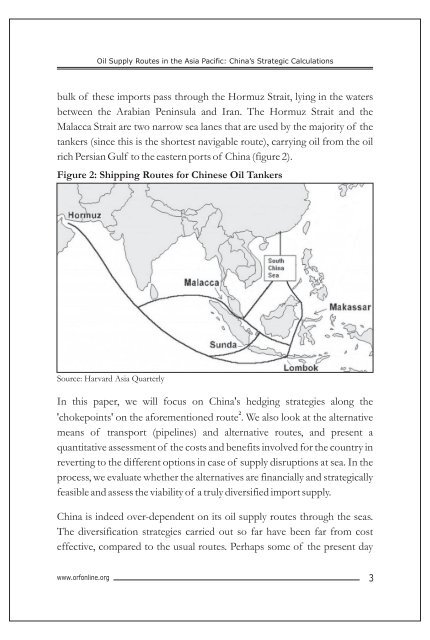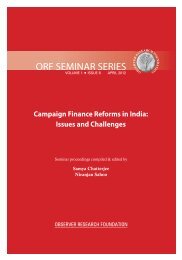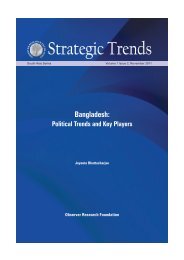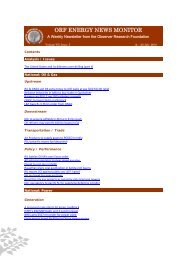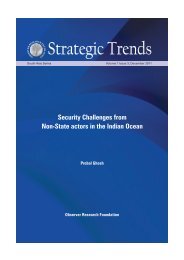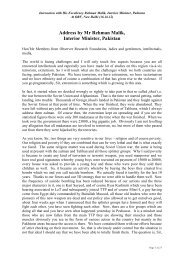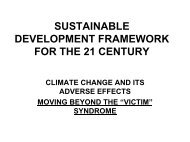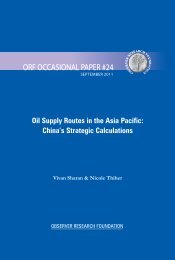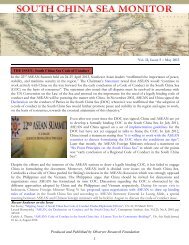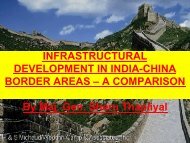Oil Supply Routes in the Asia Pacific: China's Strategic Calculations
Oil Supply Routes in the Asia Pacific: China's Strategic Calculations
Oil Supply Routes in the Asia Pacific: China's Strategic Calculations
You also want an ePaper? Increase the reach of your titles
YUMPU automatically turns print PDFs into web optimized ePapers that Google loves.
<strong>Oil</strong> <strong>Supply</strong> <strong>Routes</strong> <strong>in</strong> <strong>the</strong> <strong>Asia</strong> <strong>Pacific</strong>: Ch<strong>in</strong>a’s <strong>Strategic</strong> <strong>Calculations</strong><br />
bulk of <strong>the</strong>se imports pass through <strong>the</strong> Hormuz Strait, ly<strong>in</strong>g <strong>in</strong> <strong>the</strong> waters<br />
between <strong>the</strong> Arabian Pen<strong>in</strong>sula and Iran. The Hormuz Strait and <strong>the</strong><br />
Malacca Strait are two narrow sea lanes that are used by <strong>the</strong> majority of <strong>the</strong><br />
tankers (s<strong>in</strong>ce this is <strong>the</strong> shortest navigable route), carry<strong>in</strong>g oil from <strong>the</strong> oil<br />
rich Persian Gulf to <strong>the</strong> eastern ports of Ch<strong>in</strong>a (figure 2).<br />
Figure 2: Shipp<strong>in</strong>g <strong>Routes</strong> for Ch<strong>in</strong>ese <strong>Oil</strong> Tankers<br />
Source: Harvard <strong>Asia</strong> Quarterly<br />
In this paper, we will focus on Ch<strong>in</strong>a's hedg<strong>in</strong>g strategies along <strong>the</strong><br />
2<br />
'chokepo<strong>in</strong>ts' on <strong>the</strong> aforementioned route . We also look at <strong>the</strong> alternative<br />
means of transport (pipel<strong>in</strong>es) and alternative routes, and present a<br />
quantitative assessment of <strong>the</strong> costs and benefits <strong>in</strong>volved for <strong>the</strong> country <strong>in</strong><br />
revert<strong>in</strong>g to <strong>the</strong> different options <strong>in</strong> case of supply disruptions at sea. In <strong>the</strong><br />
process, we evaluate whe<strong>the</strong>r <strong>the</strong> alternatives are f<strong>in</strong>ancially and strategically<br />
feasible and assess <strong>the</strong> viability of a truly diversified import supply.<br />
Ch<strong>in</strong>a is <strong>in</strong>deed over-dependent on its oil supply routes through <strong>the</strong> seas.<br />
The diversification strategies carried out so far have been far from cost<br />
effective, compared to <strong>the</strong> usual routes. Perhaps some of <strong>the</strong> present day<br />
www.orfonl<strong>in</strong>e.org 3


